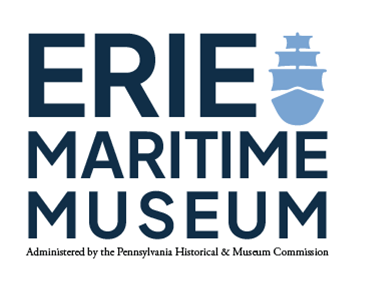Our Collections
The Erie Maritime Museum has a diverse collection of three-dimensional objects and archival documents – totaling nearly 3,000 separate items. While most are in storage, some are used for our exhibits, and loans to other Pennsylvania Historical and Museum Commission sites and other regional museums.
Visitors can look at our artifacts and collections throughout the museum exhibits as well as request to view items or documents in storage for research purposes with an approved appointment. To request access, please contact us in advance by email or phone.
If you are interested in donating to the Erie Maritime Museum’s collection, please get in touch with Jeff Seymour for more information regarding our collection’s policy and process.
-
In addition to naval objects related to the Battle of Lake Erie, collections include artifacts that tell the story of the soldiers and militia who fought alongside Oliver Hazard Perry’s crew and protected the young town at Presque Isle throughout the War. Commemorative objects from significant anniversaries are also featured.
-
Erie’s sheltered harbor made it the ideal place to build Perry’s squadron. Shipbuilding and repair remains a fundamental waterfront industry to this day. Our collections hold a substantial number of tools, focusing on the 19th and early 20th Century - telling the story of one of Erie’s longest standing traditions.
-
The US Navy’s first “Iron Steamer”, launched in 1843, made Erie her home port for a career spanning nearly eight decades. Collections focus on the officers and men who trained and served aboard her. Made up by images, correspondence, tools, and personal objects that draw you into their world, telling their story.
-
Erie Maritime Museum’s art collection include fine art created by nationally renowned local artists Joseph Plavcan and Roy Ahlgren. More recently, the Museum obtained world-renowned 19th century Maritime Artist, Julian O. Davidson’s The Battle of Lake Erie. Selections range from naval warfare to calming lake scenes.
-
As Pennsylvania's only freshwater port, Erie Harbor bustled with industries supporting maritime technologies and commerce, and commercial fishing. Collections include engines, navigational and safety equipment, as well as personal objects and archival material that create a picture of life and work in maritime trades.
-
Erie, Pennsylvania is home to one of the finest harbors on Lake Erie. Throughout the year, residents and tourists alike can be found on and around the waters of Lake Erie. Our collections focus on objects that showcase leisure and fun during the 20th Century, from outboard motors to postcards.
-
One of the most influential children of Erie, Pennsylvania - William Morrison was an naval officer, the first Superintendent of Presque Isle State Park, Commodore of the Erie Yacht Club, and so much more.
-
Every harbor's history includes dramatic stories of wreck and rescue - Erie is no exception. The Museum's collections include uniforms, equipment, photographs, logbooks documenting the activities of the U.S. Revenue Cutter Service, U.S. Life-Saving Service, and finally, the U.S. Coast Guard, Presque Isle Station.
-
Since the War of 1812, the United States Navy has had a continuing presence in Erie shaped the character of the city and her citizens, and still inspires the service of young men and women here. Collections include objects from the careers of Erie men who achieved the US Navy’s highest ranks.
-
Erie Maritime Museum’s collection of ship models represent the vessels commonly seen in Erie Harbor, from wooden ships of the 19th century to the modern iron-hulled ore carriers. Collections of half models used by historic 20th century Erie ship builders such as Paasch Brothers.
Did you know that you can explore PHMC’s collections online? Visit our database and explore over 300 years of Commonwealth history!
These artifacts celebrate the commonwealth's social, cultural, natural, and economic diversity. This online collection tells the story of Pennsylvania by highlighting the history of the commonwealth's diverse objects - including some of the Erie Maritime Museum’s more treasured objects.


